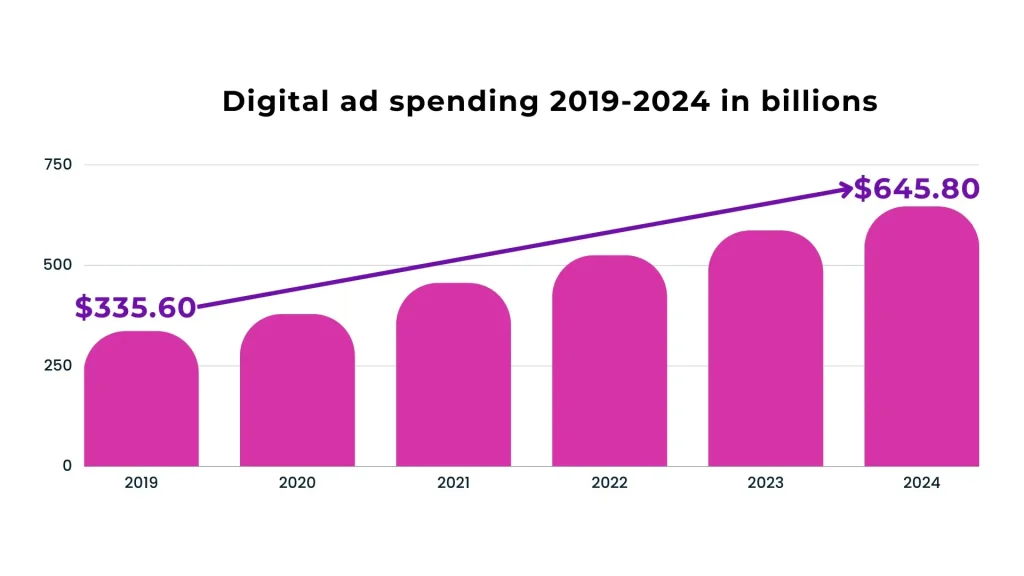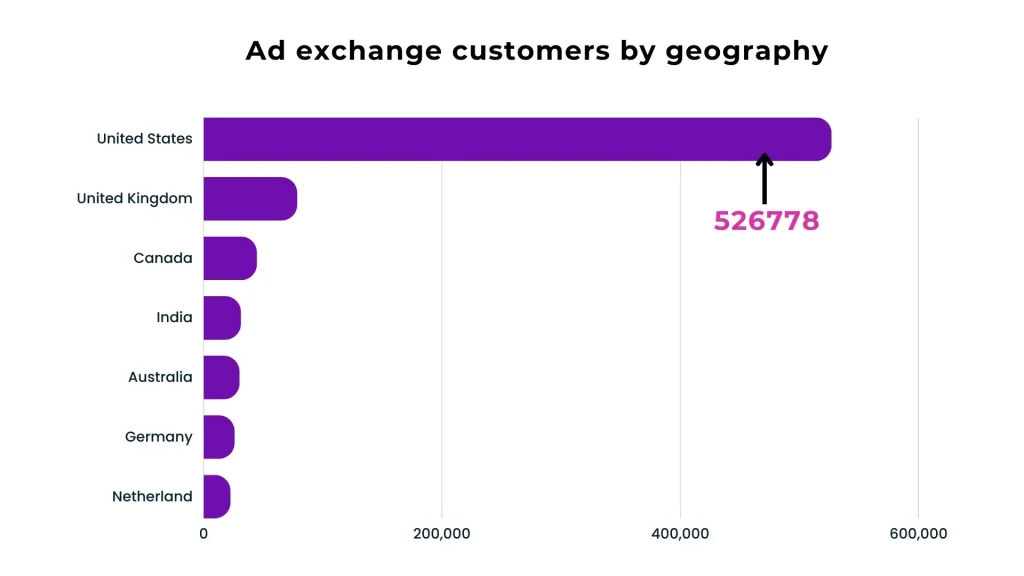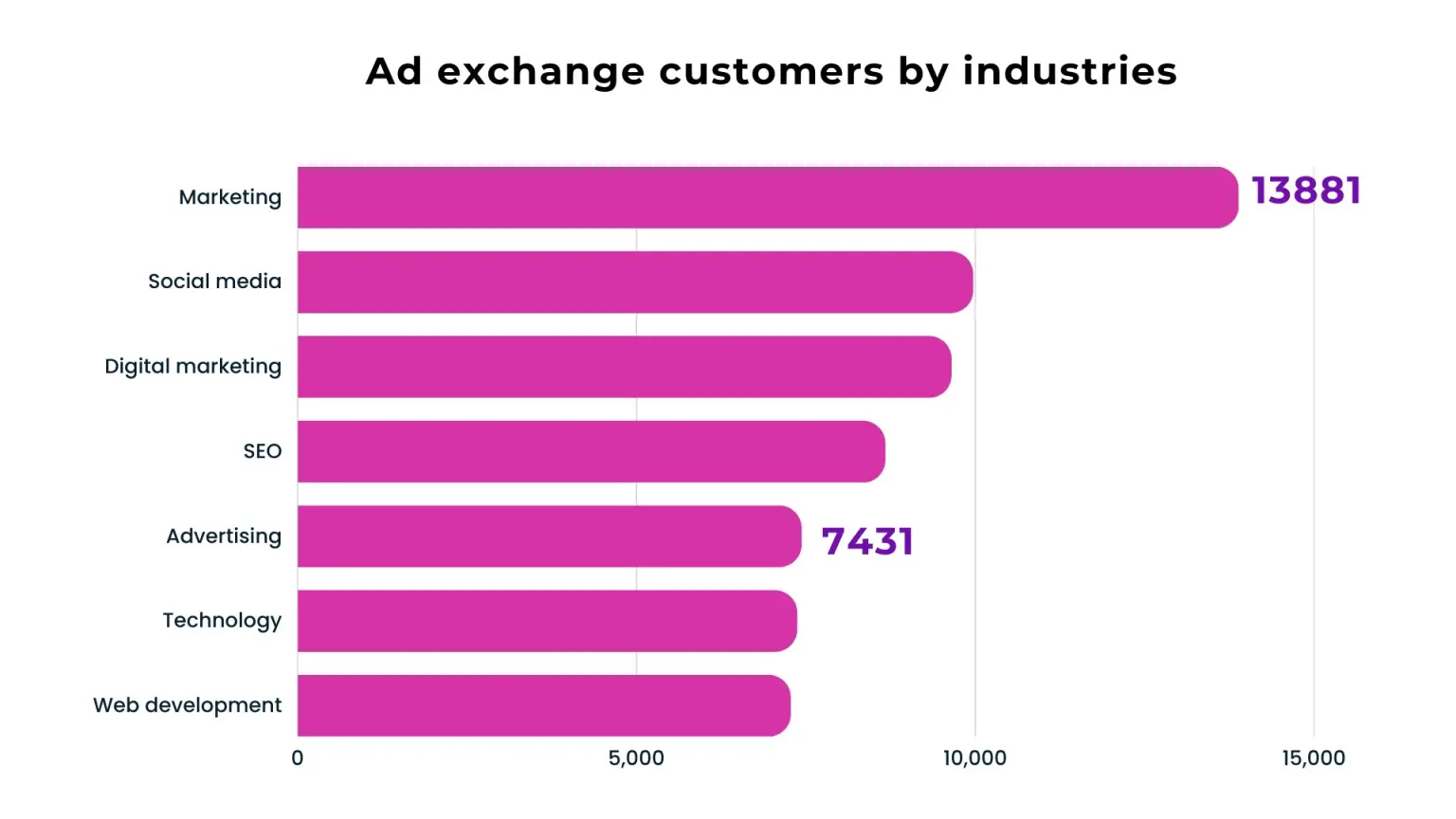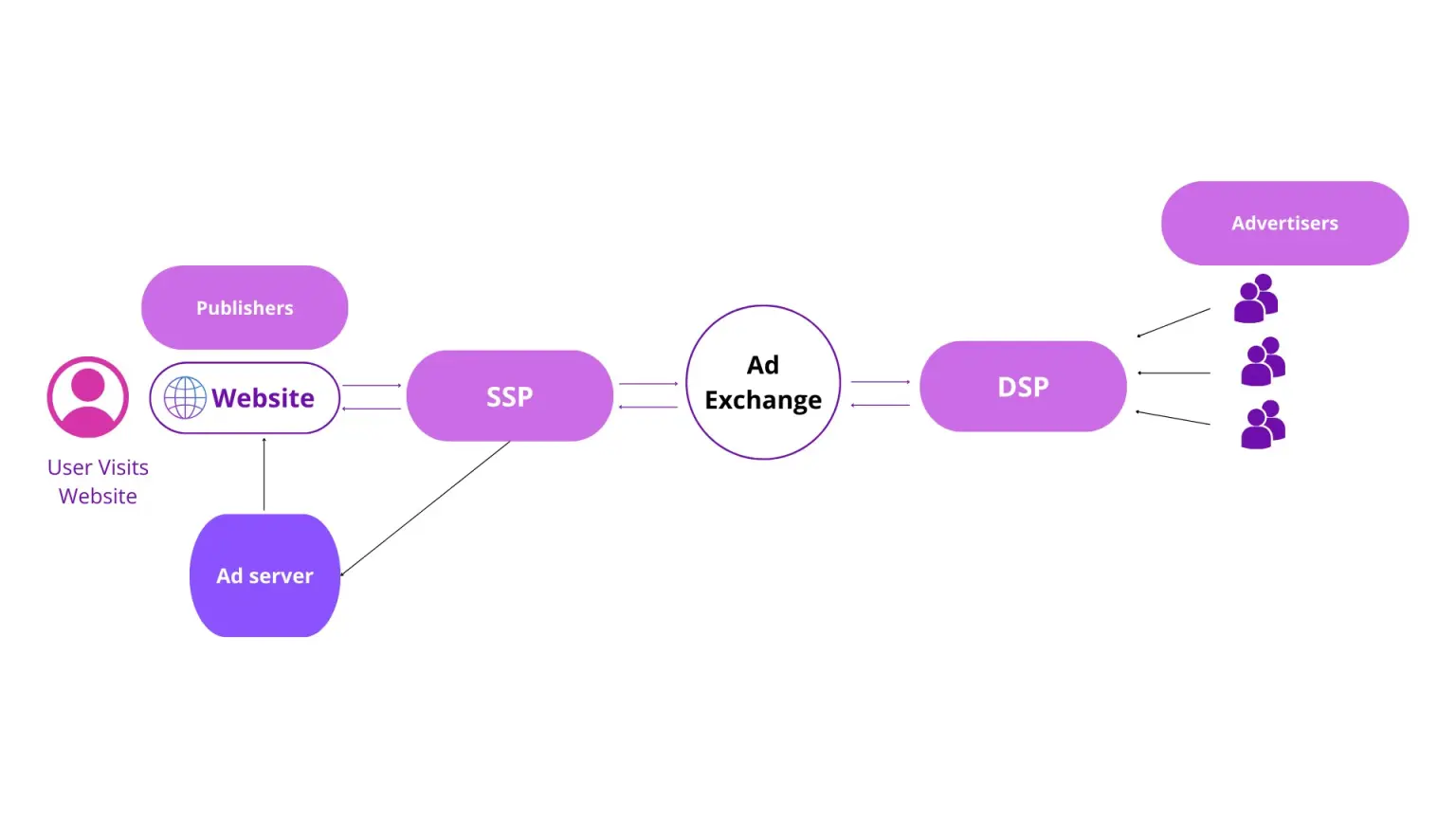Ads are the key revenue of publishers and advertisers. Global spending on digital ads keeps increasing yearly and will reach $650 billion in 2024. Ad exchanges play a major role in distributing these ads.

In the ad tech ecosystem, many publishers and advertisers use ad exchanges, and 994,727 companies use ad exchange software, but few can explain what an ad exchange is. It is a $600 billion question demanding a clear explanation of what it is, how it works, why publishers should use it, its benefits, and everything else.
So, to get you started, this blog takes you through an extensive guide on ad exchange and gives you knowledge that professional publishers should have.
Table of Contents
What Is Ad Exchange?
An ad exchange is an online marketplace and an intermediate that facilitates the buying and selling ad space between publishers and advertisers in real time. It comes under the programmatic advertising industry. It is an open marketplace that runs auctions in real-time, connects the publishers with wider demands, and gets the best price for the ad inventory.
On the other hand, it connects the advertisers with the ideal publishers for their ad campaign and gets the best ad slot. The publishers could be website owners, bloggers, and online magazines. Advertisers could be brands, service providers, and performance marketers.
The ad exchange is a popular programmatic medium in ad tech. It eventually raised the popularity of ad exchange software, which different customers and industries now use in different geographical areas.


The ad selling and buying process is automated with advanced algorithms and software. The entire process is happening with the rule of supply and demand. Publishers want high prices for their ad space. Advertisers want the best ad slots at low costs.
Types of Ad Exchange
Open exchanges: It is a completely transparent marketplace that is open to all. Any publishers and advertisers can participate in real-time bidding. Publishers can quote their requirements, like floor price, and send ad requests. Advertisers can bid for ad slot that matches their line items. The exchange will match the suitable publisher with the advertiser and complete the deal.
Private exchanges: It is an invite-only ad exchange. A closed marketplace that is exclusive to premium advertisers. Publishers allow selected advertisers to participate in the auction. You will have more control over the inventory, perform direct relationships with premium advertisers, and get high CPMs for impressions. A private marketplace works only for premium publishers who have high followers and demand for ad inventory.
Preferred exchanges: Preferred exchanges facilitate the buying and selling of ads at a fixed price with preferred advertisers. Publishers sell their ad inventory to selected advertisers at a negotiated fixed price. This type of deal guarantees high CPM and is suitable for websites with very high digital footfall.
| Feature | Open Exchange | Private Exchange | Preferred Exchange |
| Description | Open to all advertisers | Invitation-only advertisers | Inventories are sold to preferred advertisers at a fixed price. |
| Pricing | Negotiated | Negotiated | Fixed |
How Does Ad Exchange Work?
In ad buying and selling, the different components that work with ad exchanges are the publisher, advertiser, supply-side platform (SSP), demand-side platform (DSP), and ad server. These main components work together to facilitate real-time bidding that involves the following steps:
As a publisher, you use an SSP to list your inventory and connect with ad exchange. In the same way, advertisers connect with DSP to access inventory details in the ad exchange.

- When a user enters a website, the website loads. It triggers the ad request of the impression and sends it to the ad exchanges through SSP.
- The ad exchange then sends the bid request to DSP to let the advertisers bid on available impressions.
- The DSP analyzes the various metrics around the available impression to see if the requirements match with any advertiser’s
- In case of any requirement you set matches with the advertiser’s, the DSP sends a bid to the ad exchange.
- The ad exchange compares and analyzes all the bids received against your requirements, such as floor price and line items.
- The ad exchange selects the suitable bid that matches your requirements and sends the data to the SSP and ad server.
- The ad server will receive the data along with ad creative from the advertiser and will render the ads on your website or app.
With the ad exchange set up, you and the advertiser will have more control over the parameters you set and the auction process. The auction takes place in a fraction of a second, the time between the ad request trigger and the ad displayed on the site. In a minute, thousands of auction processes can happen across a huge network of SSP, DSP, and ad exchanges.
Benefits for the Publishers
There are several benefits you can achieve from using ad exchange for programmatic ad placing.
Transparency: Ad exchanges are highly transparent as they give full control to quote your requirements and ad placement. You and advertisers will get hold of the necessary information on the auction process.
High demand: You can connect with a vast network of demand partners through ad exchanges. This increased demand leads to higher CPMs, fill rate, and ad revenue.
Targeted ads: Ad exchanges share the cookie data of your user with your consent to the DSPs. It will let you offer targeted advertising, which reaps higher CPMs and yield.
Control and scalability: You will control the ads they place on your website. You can set criteria and select ad formats for your website that don’t disrupt the user experience.
Quality check: You can be assured of the quality of the ad placed and reduce the risk of showing inappropriate content. Ad exchanges work with reputable DSPs and advertisers. So, brand safety is high.
Technology filters: Ad exchanges use technology filters to filter and block ads that don’t meet the brand safety standards. Thus, it makes way for a safer advertising environment.
Ad Network Vs Ad Exchange: Which Is Better?
Again, the difference between ad networks and ad exchanges is a common confusion for every publisher.
The ad network is also an intermediary between publishers and advertisers. It collects all the remnant inventory from the publisher at one price, categorizes it according to the demography, context, and other verticals, and resells it to the advertiser at a higher price. It almost takes 40% of what you earn from the platform.
This process might seem profitable and has a higher fill rate. But the truth is different: publishers get low CPMs and not a 100% fill rate. There is very little transparency and control over ad placement and targeting. Publisher doesn’t know the details of an ad placed and who are placing the ads on their website.
Advertisers place ads on the website based on IAB categories, context, location, and browser types, hoping to be seen by exact targets. They cannot place highly targeted ads. The network is highly vulnerable to ad fraud.
Ad exchange runs real-time auctions and sells impressions to the buyers based on the user data. The price is determined based on the competition. They take a share of what you get from demand partners with a revenue-sharing model.
You can control the ad formats and placement and know who is placing ads on your website. The process is transparent, and you will get maximum yield.
Suggesting reading: Ad networks Vs. Ad exchanges: What you should know?
Difference Between Ad Exchange and SSP
Supply-side platform (SSP) is a medium for the publishers to connect with ad exchange. It is a platform to put your ad requirements, such as available inventory space, floor price, and contextual ads. SSP connects your ad request and requirements with multiple ad exchanges and networks. In the same way, the DSPs work for advertisers.
The line between SSP and ad exchange is now blurring. One of the leading causes is that many SSPs are now buying the top ad exchanges to offer all services in one place. The publishers using standalone exchanges are getting less every minute.
Here are some examples of SSPs that are now offering ad exchange services:
- Google Ad Manager: Google Ad Manager is a leading SSP that also offers an ad exchange called AdX.
- Amazon Publisher Services: Amazon Publisher Services is an SSP with its own ad exchange – Amazon Advertising Marketplace.
- OpenX: OpenX comes along with the ad exchange called OpenX Marketplace.
Points to ponder:
You can connect with one or more ad exchanges:
It is not compulsory to add only one ad exchange to your tech stack. Having one ad exchange will not broaden your demand. You can add more than one into your stack to get the highest possible CPM and fill rate consistently. Choose ad exchanges based on your needs, and if you don’t find them good after some time, you can easily remove them in a plug-and-play setup and add new ones.
The ad exchange is not the only revenue option:
You are using ad exchange to increase ad revenue. With that objective, connecting with one ad exchange, i.e., one source, is insufficient. You can use other options like direct deals and header bidding to connect with demand partners who are not using ad exchange. You might even get higher CPMs there than what an ad exchange could give. The ad exchange is just an intermediary for buying and selling ads. I am not saying this to discourage you from using ad exchange but to inform you that they aren’t the only revenue source. It is just a piece of pixel in the whole picture.
Popular Ad Exchanges
After deciding to use ad exchange, there comes the big burden of choosing the right one from the pool of thousands of ad exchanges online. Here, we have listed some handpicked exchanges to help you make decisions.
Google AdX: It is one of the top ad exchanges in the programmatic ecosystem. It is an efficient and reliable platform with robust technology for effective ad buying and selling. They offer a range of features for effective ad inventory monetization.
It is simple to set up Google AdX into your stack. They offer various user-friendly ad formats. Setting up preferred deals and dynamic floor pricing are other features it offers. Brand safety is guaranteed in this world’s largest exchange.
Magnite: A popular ad exchange, previously known as the Rubicon Project. It is an SSP turned ad exchange that connects the premium buyers to publishers. They provide better brand safety, high value for impressions, and greater control over the ad inventory.
Renowned publishers such as Conde, The Wall Street Journal, Nast, eBay, and GAMELOFT use magnite. They offer preferred deals and have a global programmatic video marketplace. They also offer a unified ID solution for publishers to increase match rates outside walled gardens,
Pubmatic: It is solely a publisher-focused ad exchange. Publishers can realize maximum revenue across devices and channels with advanced technologies. They connect publishers with diverse resources and maintain high transparency and quality.
Popular publishers such as Times Internet and Lively Media utilize Pubmatic. They have their own SSP and unified bidding solution called openwrap. Activate is another pubmatic’s end-to-end solution that allows publishers to increase revenue and transparency across CTV and video.
Xander: This platform offers a flexible and effective way to sell and buy ad space with a suite of products. They manage your inventory with the best strategies and maximize ad revenue with data-driven approaches.
You get access to premium demands, an ad server personalized to your needs, and header bidding technology in their SSP. Also, they offer a range of analytics solutions for performance tracking and forecasting.
Index Exchange: It is a trusted ad exchange with a highly transparent auction process. They offer a range of features for publishers to maximize their monetization potential. They give access to premium demands and maintain high standards for inventory quality to induce buyer confidence.
They support different addressability solutions to improve targeted advertising and offer granular reporting features for a publisher to track campaign performance.
Which Is Right for You?
Now you know what ad exchange is, how it works, how it fits in your ad tech stack and the popular ad exchanges in the market. Next comes the question, which is right for you?
Just select one according to your…

Select the ad exchange that suits your needs. For instance, you might have a 100% fill rate and low revenue or less fill rate and low revenue. Choose one based on the objective you need to fulfill.
If you are starting now and want to move from AdSense to an ad exchange, look at the entry barriers put up by the popular exchanges, such as minimum traffic and first-party data. If they have a strict vetting process and you have fewer qualifications, consider accessing the renowned exchanges through a programmatic monetization partner.
In the second case, if you select ad exchange in addition to your other demand. Consider selecting an ad exchange that gives unique demand or at least checks if they can get you higher CPMs from the demand that you are already connected with.
Hence, the first factor to consider in choosing the right exchange is your needs. Besides this, you must look at factors such as brand safety, quality ads, payment terms, popularity and reputation, and ad formats they offer.
If you search and pick the ad exchanges based on your needs and other important factors, you will automatically driven to the one choice destined for you. I hope you have gained full insight into ad exchange. To understand adtech jargon in layperson’s terms, read more content on our website, headerbidding. co.
FAQs
1. What is an ad exchange, and how does it work?
It is an open marketplace that facilitates the selling and buying ad space on websites and apps. The auction process happens in real-time, which is called real-time bidding, with a group of components such as SSP, DSP, and ad server.
2. What is the world’s largest ad exchange?
Google AdX is the world’s largest ad exchange with a 50% market share. It is a reliable platform that employs robust technology and data-driven approaches to perform an effective auction process.
3. How do ad exchanges make money?
Revenue sharing is the revenue mode of ad exchanges. They take a share of a certain percentage of every transaction on the platform.
4. Who uses ad exchange?
Publishers and advertisers are the main users. Publishers include website owners, online magazines, and bloggers. Advertisers include brands, services, and marketers.
5. What is the difference between an ad network and an ad exchange?
An ad network is a platform that collects the consolidated inventory from the publishers at a fixed price and resells it to advertisers at a high price. The ad buying and selling process in the ad network is not transparent and is inflexible. At the same time, ad exchange conducts an auction process in real-time to get high CPMs for the publisher’s ad inventory and the best ad slot for advertisers. RTB is highly transparent and gives complete control over the auction.























